Heytsbury Holdings Limited: Financial and Marketing Analysis
VerifiedAdded on 2023/06/08
|11
|3080
|244
Essay
AI Summary
This essay examines the business practices of Heytsbury Holdings Limited (HHL), focusing on its financial and marketing strategies, organizational structure, and people management. The essay begins by defining organizations and their key components, referencing Schermerhorn et al. (2012) and the American Marketing Association (2013), and then delves into HHL's application of contemporary marketing practices, emphasizing relationship marketing and the use of social media, as well as the importance of customer satisfaction. The financial practices of HHL are then assessed, including budgeting, financial forecasting, and the ethical standards followed by the company. The value proposition of HHL is explored in terms of its products and services, particularly in relation to its expansion through franchising. The organizational structure and people management practices of HHL are also investigated, including the company's structure and the role of its workforce. The essay incorporates references from Bovée and Thill (2015), Aremu and Bamiduro (2012), and others to support its analysis and to provide a comprehensive understanding of HHL's business operations. The essay also discusses the interdependences among the core functions of HHL and the ways in which this interrelationship might influence the decision-making processes. The analysis is based on the case study of HHL and its application of marketing and financial practices in the current market.
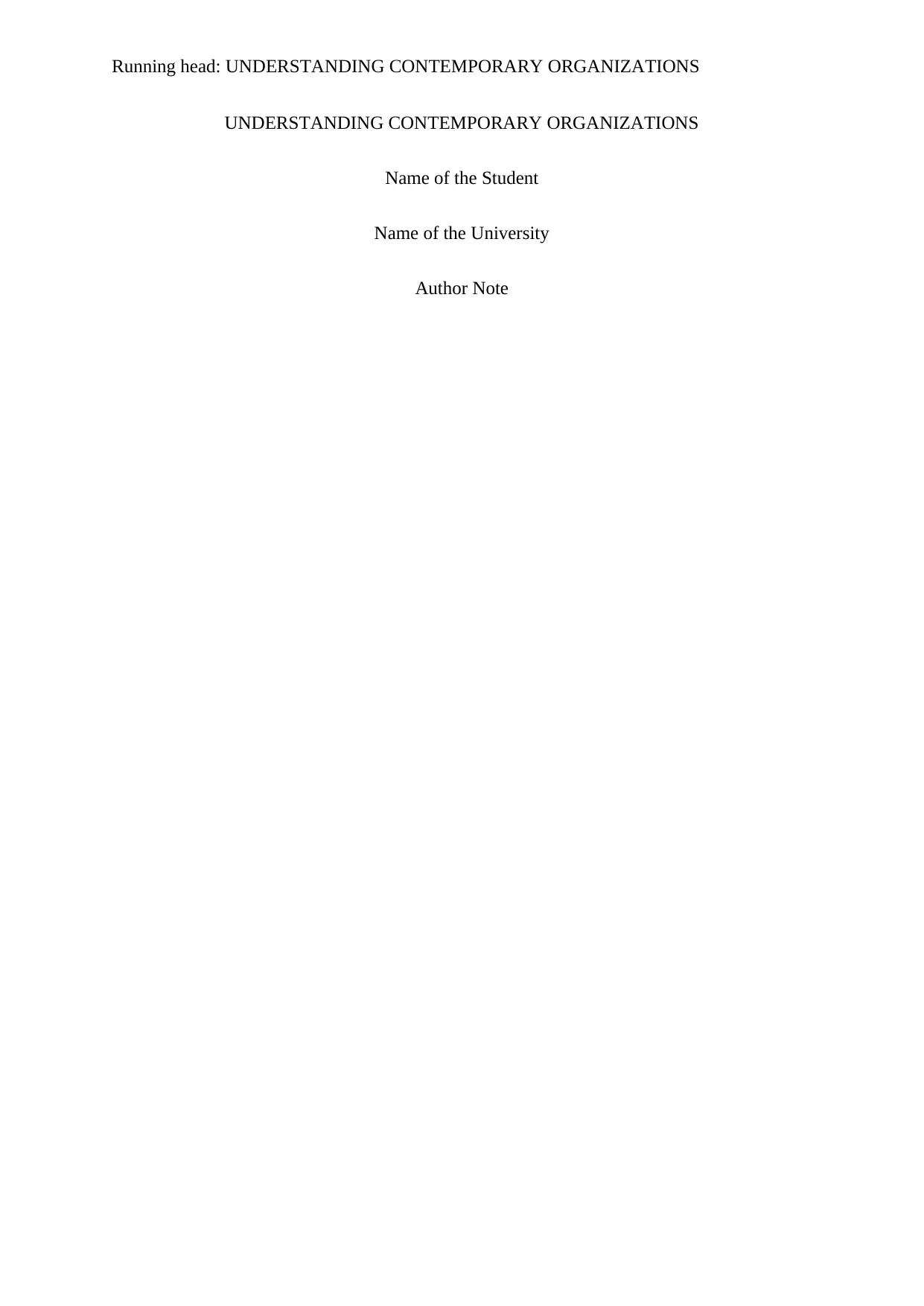
Running head: UNDERSTANDING CONTEMPORARY ORGANIZATIONS
UNDERSTANDING CONTEMPORARY ORGANIZATIONS
Name of the Student
Name of the University
Author Note
UNDERSTANDING CONTEMPORARY ORGANIZATIONS
Name of the Student
Name of the University
Author Note
Paraphrase This Document
Need a fresh take? Get an instant paraphrase of this document with our AI Paraphraser
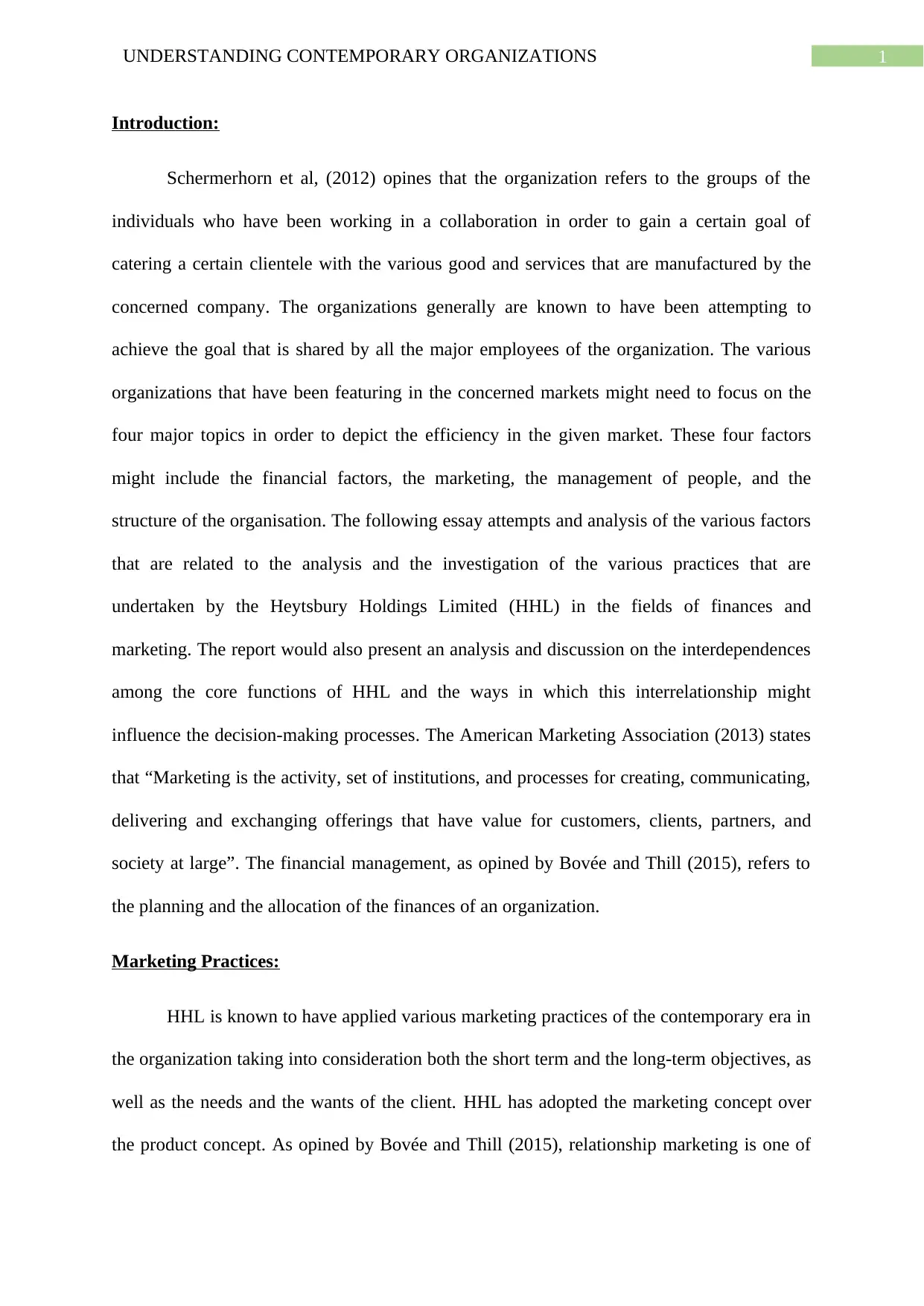
1UNDERSTANDING CONTEMPORARY ORGANIZATIONS
Introduction:
Schermerhorn et al, (2012) opines that the organization refers to the groups of the
individuals who have been working in a collaboration in order to gain a certain goal of
catering a certain clientele with the various good and services that are manufactured by the
concerned company. The organizations generally are known to have been attempting to
achieve the goal that is shared by all the major employees of the organization. The various
organizations that have been featuring in the concerned markets might need to focus on the
four major topics in order to depict the efficiency in the given market. These four factors
might include the financial factors, the marketing, the management of people, and the
structure of the organisation. The following essay attempts and analysis of the various factors
that are related to the analysis and the investigation of the various practices that are
undertaken by the Heytsbury Holdings Limited (HHL) in the fields of finances and
marketing. The report would also present an analysis and discussion on the interdependences
among the core functions of HHL and the ways in which this interrelationship might
influence the decision-making processes. The American Marketing Association (2013) states
that “Marketing is the activity, set of institutions, and processes for creating, communicating,
delivering and exchanging offerings that have value for customers, clients, partners, and
society at large”. The financial management, as opined by Bovée and Thill (2015), refers to
the planning and the allocation of the finances of an organization.
Marketing Practices:
HHL is known to have applied various marketing practices of the contemporary era in
the organization taking into consideration both the short term and the long-term objectives, as
well as the needs and the wants of the client. HHL has adopted the marketing concept over
the product concept. As opined by Bovée and Thill (2015), relationship marketing is one of
Introduction:
Schermerhorn et al, (2012) opines that the organization refers to the groups of the
individuals who have been working in a collaboration in order to gain a certain goal of
catering a certain clientele with the various good and services that are manufactured by the
concerned company. The organizations generally are known to have been attempting to
achieve the goal that is shared by all the major employees of the organization. The various
organizations that have been featuring in the concerned markets might need to focus on the
four major topics in order to depict the efficiency in the given market. These four factors
might include the financial factors, the marketing, the management of people, and the
structure of the organisation. The following essay attempts and analysis of the various factors
that are related to the analysis and the investigation of the various practices that are
undertaken by the Heytsbury Holdings Limited (HHL) in the fields of finances and
marketing. The report would also present an analysis and discussion on the interdependences
among the core functions of HHL and the ways in which this interrelationship might
influence the decision-making processes. The American Marketing Association (2013) states
that “Marketing is the activity, set of institutions, and processes for creating, communicating,
delivering and exchanging offerings that have value for customers, clients, partners, and
society at large”. The financial management, as opined by Bovée and Thill (2015), refers to
the planning and the allocation of the finances of an organization.
Marketing Practices:
HHL is known to have applied various marketing practices of the contemporary era in
the organization taking into consideration both the short term and the long-term objectives, as
well as the needs and the wants of the client. HHL has adopted the marketing concept over
the product concept. As opined by Bovée and Thill (2015), relationship marketing is one of
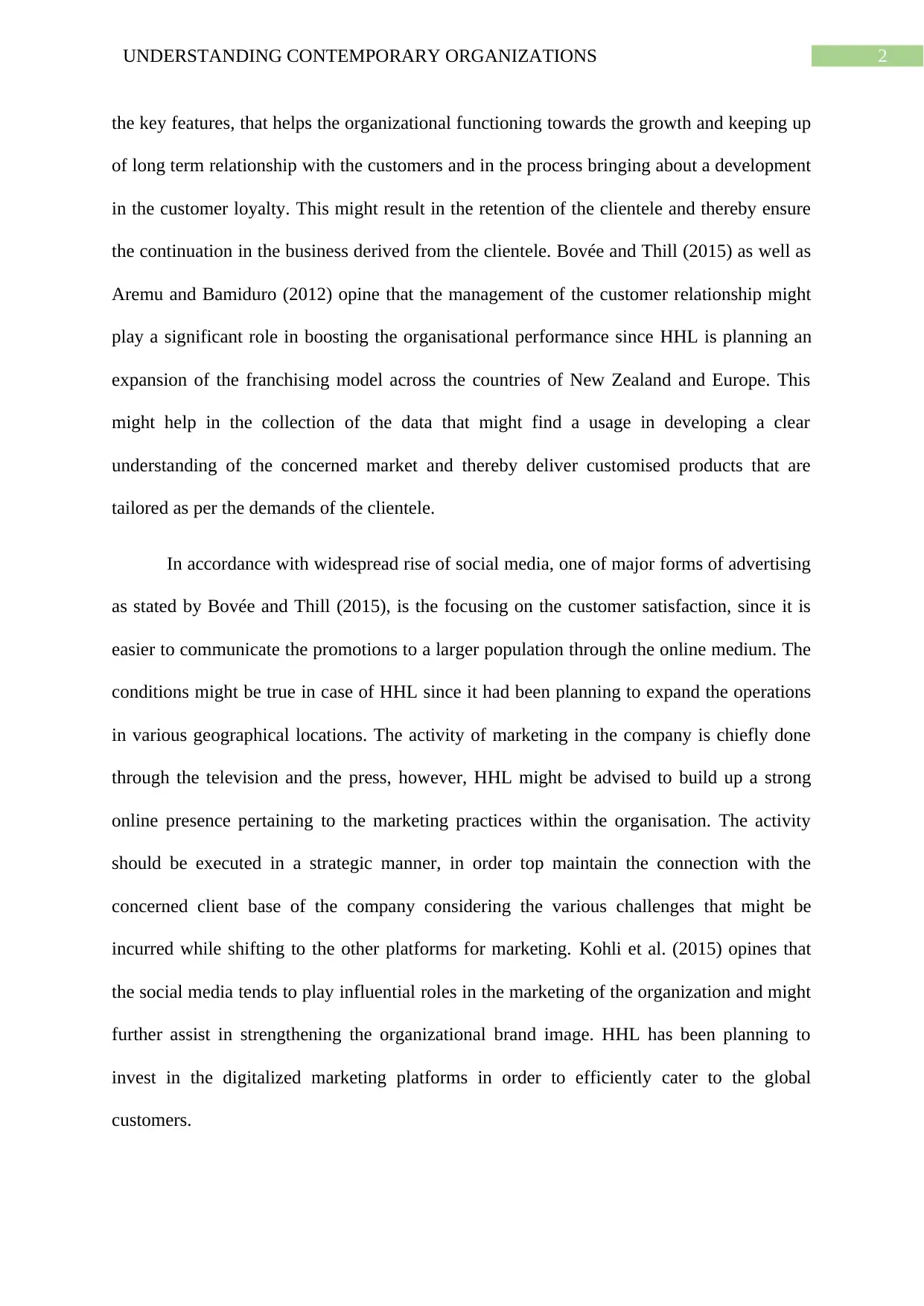
2UNDERSTANDING CONTEMPORARY ORGANIZATIONS
the key features, that helps the organizational functioning towards the growth and keeping up
of long term relationship with the customers and in the process bringing about a development
in the customer loyalty. This might result in the retention of the clientele and thereby ensure
the continuation in the business derived from the clientele. Bovée and Thill (2015) as well as
Aremu and Bamiduro (2012) opine that the management of the customer relationship might
play a significant role in boosting the organisational performance since HHL is planning an
expansion of the franchising model across the countries of New Zealand and Europe. This
might help in the collection of the data that might find a usage in developing a clear
understanding of the concerned market and thereby deliver customised products that are
tailored as per the demands of the clientele.
In accordance with widespread rise of social media, one of major forms of advertising
as stated by Bovée and Thill (2015), is the focusing on the customer satisfaction, since it is
easier to communicate the promotions to a larger population through the online medium. The
conditions might be true in case of HHL since it had been planning to expand the operations
in various geographical locations. The activity of marketing in the company is chiefly done
through the television and the press, however, HHL might be advised to build up a strong
online presence pertaining to the marketing practices within the organisation. The activity
should be executed in a strategic manner, in order top maintain the connection with the
concerned client base of the company considering the various challenges that might be
incurred while shifting to the other platforms for marketing. Kohli et al. (2015) opines that
the social media tends to play influential roles in the marketing of the organization and might
further assist in strengthening the organizational brand image. HHL has been planning to
invest in the digitalized marketing platforms in order to efficiently cater to the global
customers.
the key features, that helps the organizational functioning towards the growth and keeping up
of long term relationship with the customers and in the process bringing about a development
in the customer loyalty. This might result in the retention of the clientele and thereby ensure
the continuation in the business derived from the clientele. Bovée and Thill (2015) as well as
Aremu and Bamiduro (2012) opine that the management of the customer relationship might
play a significant role in boosting the organisational performance since HHL is planning an
expansion of the franchising model across the countries of New Zealand and Europe. This
might help in the collection of the data that might find a usage in developing a clear
understanding of the concerned market and thereby deliver customised products that are
tailored as per the demands of the clientele.
In accordance with widespread rise of social media, one of major forms of advertising
as stated by Bovée and Thill (2015), is the focusing on the customer satisfaction, since it is
easier to communicate the promotions to a larger population through the online medium. The
conditions might be true in case of HHL since it had been planning to expand the operations
in various geographical locations. The activity of marketing in the company is chiefly done
through the television and the press, however, HHL might be advised to build up a strong
online presence pertaining to the marketing practices within the organisation. The activity
should be executed in a strategic manner, in order top maintain the connection with the
concerned client base of the company considering the various challenges that might be
incurred while shifting to the other platforms for marketing. Kohli et al. (2015) opines that
the social media tends to play influential roles in the marketing of the organization and might
further assist in strengthening the organizational brand image. HHL has been planning to
invest in the digitalized marketing platforms in order to efficiently cater to the global
customers.
⊘ This is a preview!⊘
Do you want full access?
Subscribe today to unlock all pages.

Trusted by 1+ million students worldwide
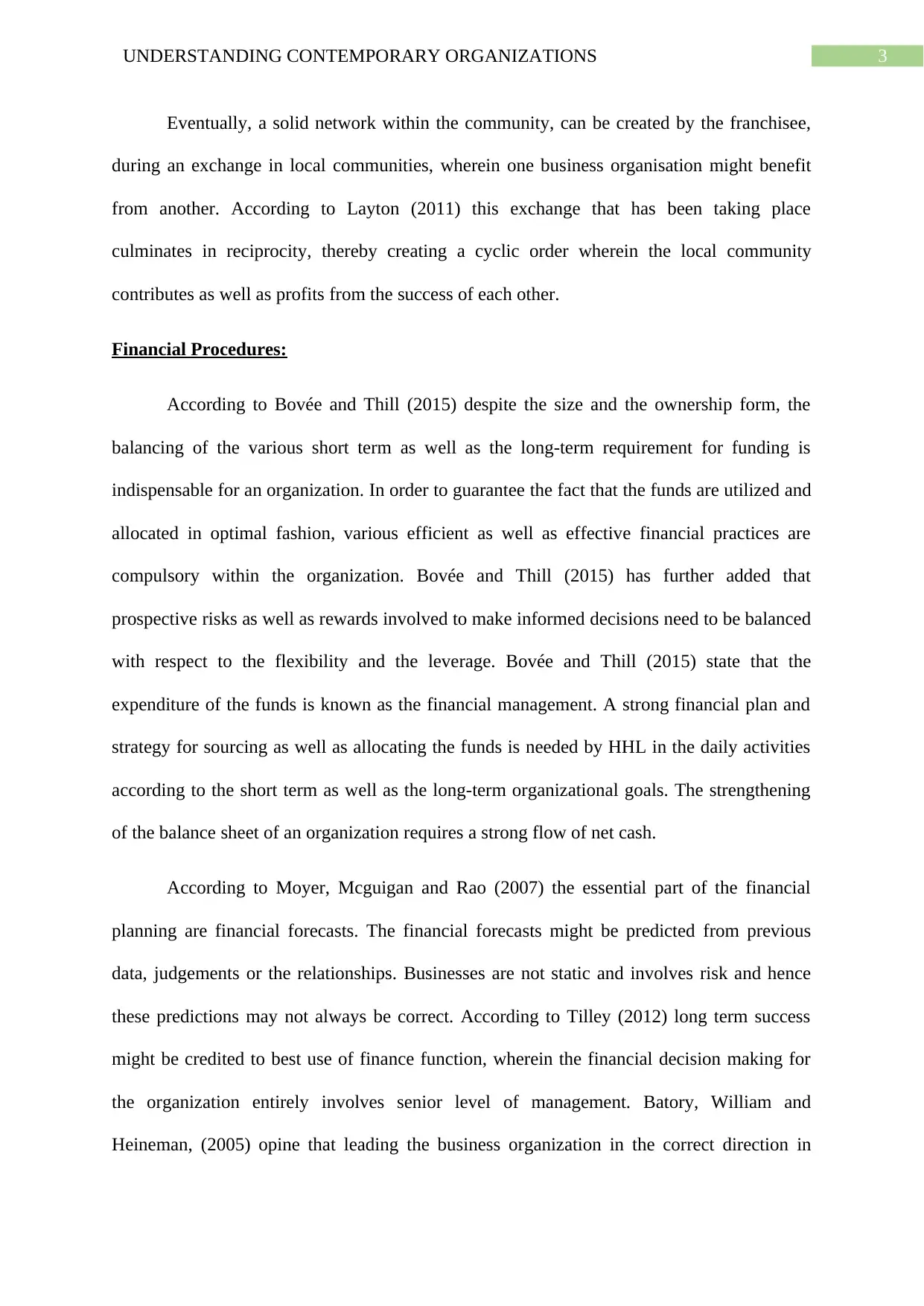
3UNDERSTANDING CONTEMPORARY ORGANIZATIONS
Eventually, a solid network within the community, can be created by the franchisee,
during an exchange in local communities, wherein one business organisation might benefit
from another. According to Layton (2011) this exchange that has been taking place
culminates in reciprocity, thereby creating a cyclic order wherein the local community
contributes as well as profits from the success of each other.
Financial Procedures:
According to Bovée and Thill (2015) despite the size and the ownership form, the
balancing of the various short term as well as the long-term requirement for funding is
indispensable for an organization. In order to guarantee the fact that the funds are utilized and
allocated in optimal fashion, various efficient as well as effective financial practices are
compulsory within the organization. Bovée and Thill (2015) has further added that
prospective risks as well as rewards involved to make informed decisions need to be balanced
with respect to the flexibility and the leverage. Bovée and Thill (2015) state that the
expenditure of the funds is known as the financial management. A strong financial plan and
strategy for sourcing as well as allocating the funds is needed by HHL in the daily activities
according to the short term as well as the long-term organizational goals. The strengthening
of the balance sheet of an organization requires a strong flow of net cash.
According to Moyer, Mcguigan and Rao (2007) the essential part of the financial
planning are financial forecasts. The financial forecasts might be predicted from previous
data, judgements or the relationships. Businesses are not static and involves risk and hence
these predictions may not always be correct. According to Tilley (2012) long term success
might be credited to best use of finance function, wherein the financial decision making for
the organization entirely involves senior level of management. Batory, William and
Heineman, (2005) opine that leading the business organization in the correct direction in
Eventually, a solid network within the community, can be created by the franchisee,
during an exchange in local communities, wherein one business organisation might benefit
from another. According to Layton (2011) this exchange that has been taking place
culminates in reciprocity, thereby creating a cyclic order wherein the local community
contributes as well as profits from the success of each other.
Financial Procedures:
According to Bovée and Thill (2015) despite the size and the ownership form, the
balancing of the various short term as well as the long-term requirement for funding is
indispensable for an organization. In order to guarantee the fact that the funds are utilized and
allocated in optimal fashion, various efficient as well as effective financial practices are
compulsory within the organization. Bovée and Thill (2015) has further added that
prospective risks as well as rewards involved to make informed decisions need to be balanced
with respect to the flexibility and the leverage. Bovée and Thill (2015) state that the
expenditure of the funds is known as the financial management. A strong financial plan and
strategy for sourcing as well as allocating the funds is needed by HHL in the daily activities
according to the short term as well as the long-term organizational goals. The strengthening
of the balance sheet of an organization requires a strong flow of net cash.
According to Moyer, Mcguigan and Rao (2007) the essential part of the financial
planning are financial forecasts. The financial forecasts might be predicted from previous
data, judgements or the relationships. Businesses are not static and involves risk and hence
these predictions may not always be correct. According to Tilley (2012) long term success
might be credited to best use of finance function, wherein the financial decision making for
the organization entirely involves senior level of management. Batory, William and
Heineman, (2005) opine that leading the business organization in the correct direction in
Paraphrase This Document
Need a fresh take? Get an instant paraphrase of this document with our AI Paraphraser
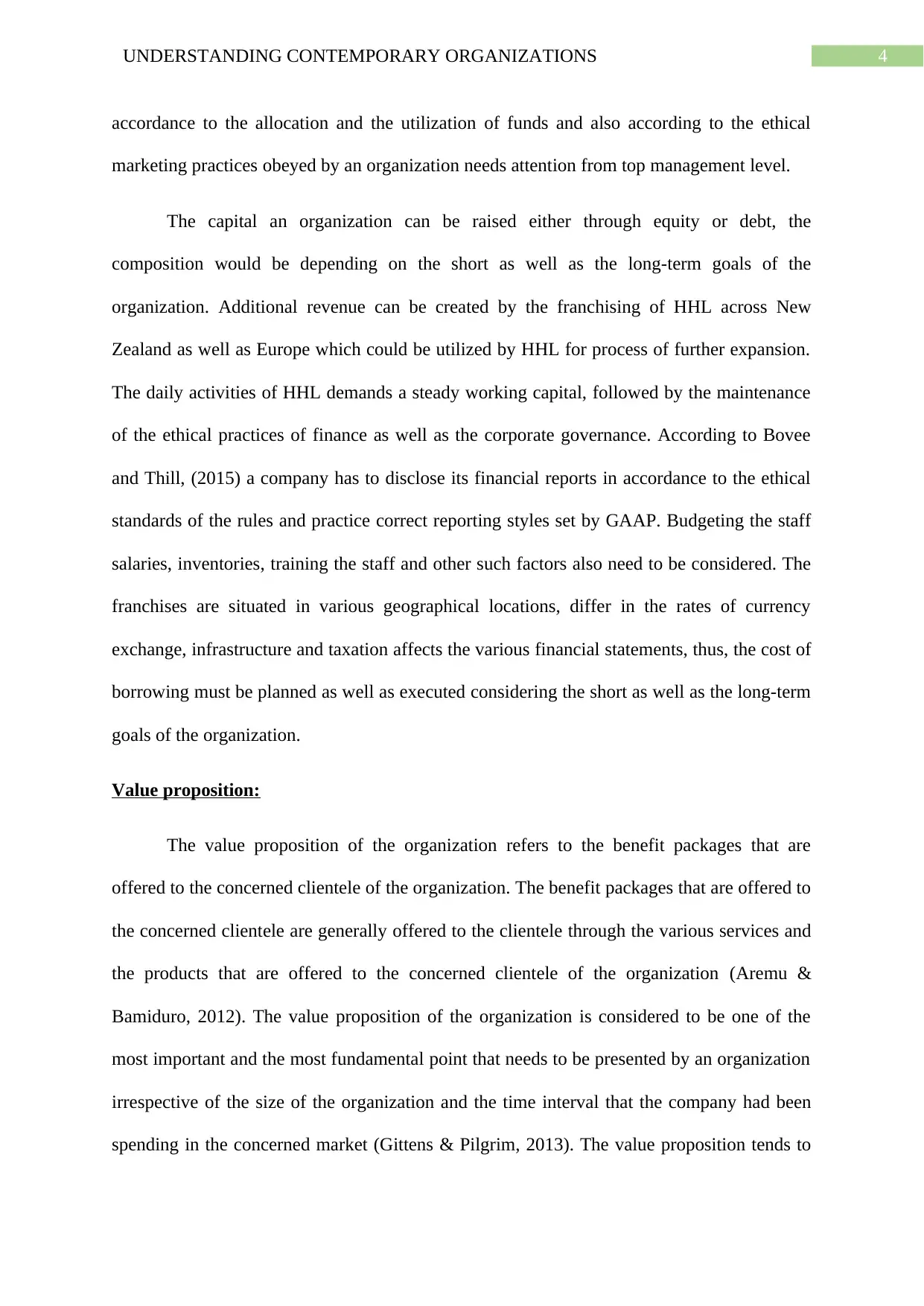
4UNDERSTANDING CONTEMPORARY ORGANIZATIONS
accordance to the allocation and the utilization of funds and also according to the ethical
marketing practices obeyed by an organization needs attention from top management level.
The capital an organization can be raised either through equity or debt, the
composition would be depending on the short as well as the long-term goals of the
organization. Additional revenue can be created by the franchising of HHL across New
Zealand as well as Europe which could be utilized by HHL for process of further expansion.
The daily activities of HHL demands a steady working capital, followed by the maintenance
of the ethical practices of finance as well as the corporate governance. According to Bovee
and Thill, (2015) a company has to disclose its financial reports in accordance to the ethical
standards of the rules and practice correct reporting styles set by GAAP. Budgeting the staff
salaries, inventories, training the staff and other such factors also need to be considered. The
franchises are situated in various geographical locations, differ in the rates of currency
exchange, infrastructure and taxation affects the various financial statements, thus, the cost of
borrowing must be planned as well as executed considering the short as well as the long-term
goals of the organization.
Value proposition:
The value proposition of the organization refers to the benefit packages that are
offered to the concerned clientele of the organization. The benefit packages that are offered to
the concerned clientele are generally offered to the clientele through the various services and
the products that are offered to the concerned clientele of the organization (Aremu &
Bamiduro, 2012). The value proposition of the organization is considered to be one of the
most important and the most fundamental point that needs to be presented by an organization
irrespective of the size of the organization and the time interval that the company had been
spending in the concerned market (Gittens & Pilgrim, 2013). The value proposition tends to
accordance to the allocation and the utilization of funds and also according to the ethical
marketing practices obeyed by an organization needs attention from top management level.
The capital an organization can be raised either through equity or debt, the
composition would be depending on the short as well as the long-term goals of the
organization. Additional revenue can be created by the franchising of HHL across New
Zealand as well as Europe which could be utilized by HHL for process of further expansion.
The daily activities of HHL demands a steady working capital, followed by the maintenance
of the ethical practices of finance as well as the corporate governance. According to Bovee
and Thill, (2015) a company has to disclose its financial reports in accordance to the ethical
standards of the rules and practice correct reporting styles set by GAAP. Budgeting the staff
salaries, inventories, training the staff and other such factors also need to be considered. The
franchises are situated in various geographical locations, differ in the rates of currency
exchange, infrastructure and taxation affects the various financial statements, thus, the cost of
borrowing must be planned as well as executed considering the short as well as the long-term
goals of the organization.
Value proposition:
The value proposition of the organization refers to the benefit packages that are
offered to the concerned clientele of the organization. The benefit packages that are offered to
the concerned clientele are generally offered to the clientele through the various services and
the products that are offered to the concerned clientele of the organization (Aremu &
Bamiduro, 2012). The value proposition of the organization is considered to be one of the
most important and the most fundamental point that needs to be presented by an organization
irrespective of the size of the organization and the time interval that the company had been
spending in the concerned market (Gittens & Pilgrim, 2013). The value proposition tends to
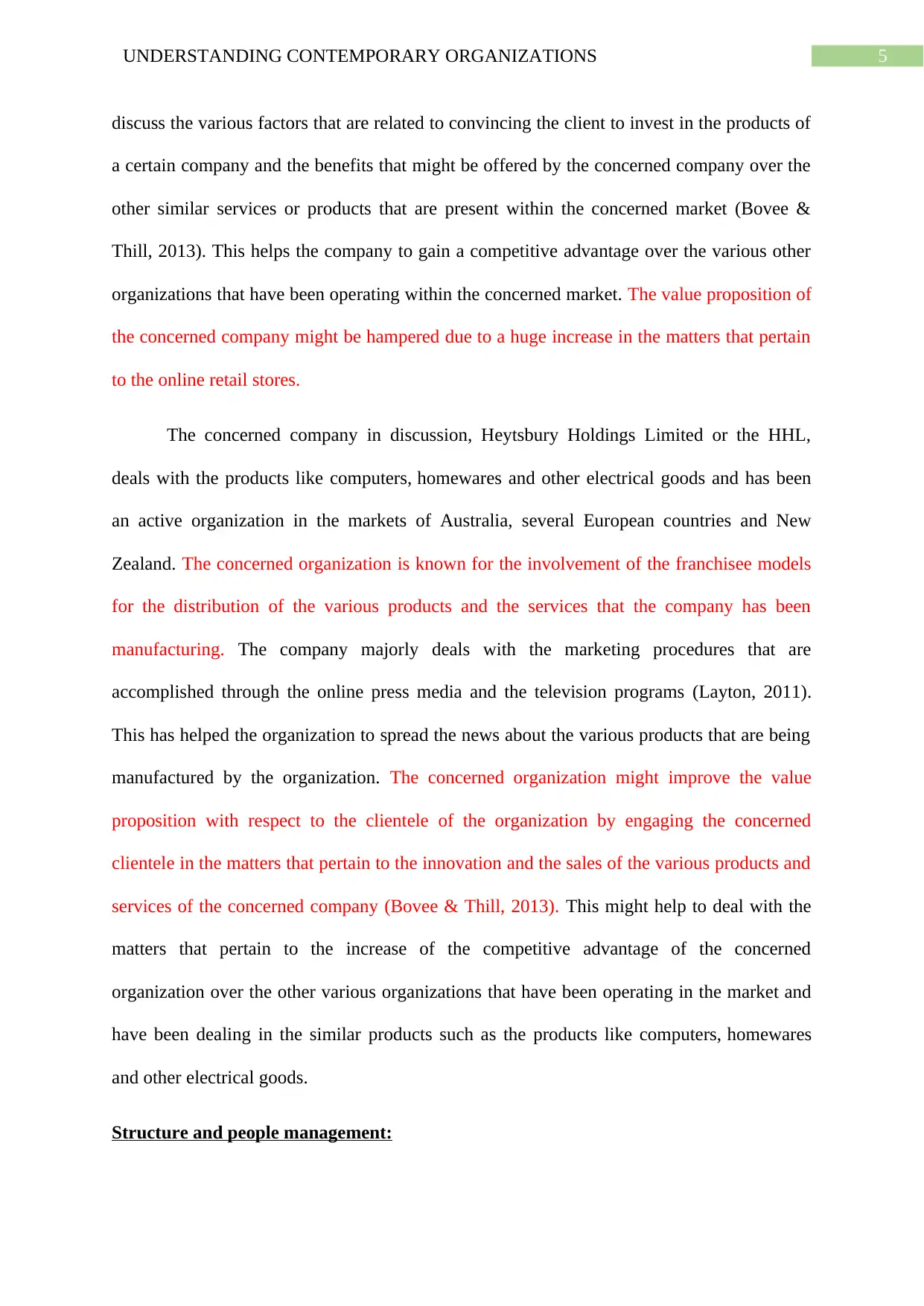
5UNDERSTANDING CONTEMPORARY ORGANIZATIONS
discuss the various factors that are related to convincing the client to invest in the products of
a certain company and the benefits that might be offered by the concerned company over the
other similar services or products that are present within the concerned market (Bovee &
Thill, 2013). This helps the company to gain a competitive advantage over the various other
organizations that have been operating within the concerned market. The value proposition of
the concerned company might be hampered due to a huge increase in the matters that pertain
to the online retail stores.
The concerned company in discussion, Heytsbury Holdings Limited or the HHL,
deals with the products like computers, homewares and other electrical goods and has been
an active organization in the markets of Australia, several European countries and New
Zealand. The concerned organization is known for the involvement of the franchisee models
for the distribution of the various products and the services that the company has been
manufacturing. The company majorly deals with the marketing procedures that are
accomplished through the online press media and the television programs (Layton, 2011).
This has helped the organization to spread the news about the various products that are being
manufactured by the organization. The concerned organization might improve the value
proposition with respect to the clientele of the organization by engaging the concerned
clientele in the matters that pertain to the innovation and the sales of the various products and
services of the concerned company (Bovee & Thill, 2013). This might help to deal with the
matters that pertain to the increase of the competitive advantage of the concerned
organization over the other various organizations that have been operating in the market and
have been dealing in the similar products such as the products like computers, homewares
and other electrical goods.
Structure and people management:
discuss the various factors that are related to convincing the client to invest in the products of
a certain company and the benefits that might be offered by the concerned company over the
other similar services or products that are present within the concerned market (Bovee &
Thill, 2013). This helps the company to gain a competitive advantage over the various other
organizations that have been operating within the concerned market. The value proposition of
the concerned company might be hampered due to a huge increase in the matters that pertain
to the online retail stores.
The concerned company in discussion, Heytsbury Holdings Limited or the HHL,
deals with the products like computers, homewares and other electrical goods and has been
an active organization in the markets of Australia, several European countries and New
Zealand. The concerned organization is known for the involvement of the franchisee models
for the distribution of the various products and the services that the company has been
manufacturing. The company majorly deals with the marketing procedures that are
accomplished through the online press media and the television programs (Layton, 2011).
This has helped the organization to spread the news about the various products that are being
manufactured by the organization. The concerned organization might improve the value
proposition with respect to the clientele of the organization by engaging the concerned
clientele in the matters that pertain to the innovation and the sales of the various products and
services of the concerned company (Bovee & Thill, 2013). This might help to deal with the
matters that pertain to the increase of the competitive advantage of the concerned
organization over the other various organizations that have been operating in the market and
have been dealing in the similar products such as the products like computers, homewares
and other electrical goods.
Structure and people management:
⊘ This is a preview!⊘
Do you want full access?
Subscribe today to unlock all pages.

Trusted by 1+ million students worldwide
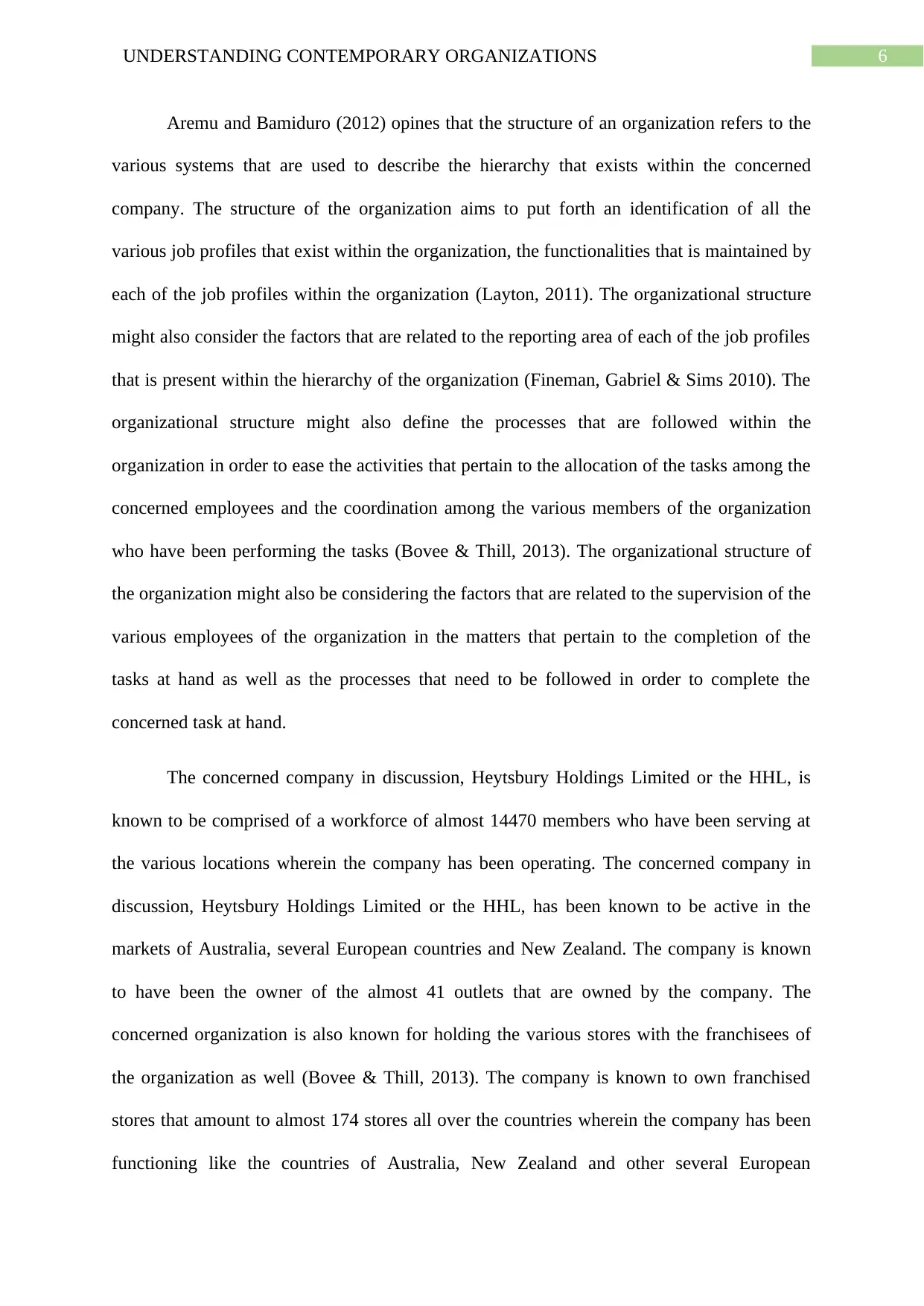
6UNDERSTANDING CONTEMPORARY ORGANIZATIONS
Aremu and Bamiduro (2012) opines that the structure of an organization refers to the
various systems that are used to describe the hierarchy that exists within the concerned
company. The structure of the organization aims to put forth an identification of all the
various job profiles that exist within the organization, the functionalities that is maintained by
each of the job profiles within the organization (Layton, 2011). The organizational structure
might also consider the factors that are related to the reporting area of each of the job profiles
that is present within the hierarchy of the organization (Fineman, Gabriel & Sims 2010). The
organizational structure might also define the processes that are followed within the
organization in order to ease the activities that pertain to the allocation of the tasks among the
concerned employees and the coordination among the various members of the organization
who have been performing the tasks (Bovee & Thill, 2013). The organizational structure of
the organization might also be considering the factors that are related to the supervision of the
various employees of the organization in the matters that pertain to the completion of the
tasks at hand as well as the processes that need to be followed in order to complete the
concerned task at hand.
The concerned company in discussion, Heytsbury Holdings Limited or the HHL, is
known to be comprised of a workforce of almost 14470 members who have been serving at
the various locations wherein the company has been operating. The concerned company in
discussion, Heytsbury Holdings Limited or the HHL, has been known to be active in the
markets of Australia, several European countries and New Zealand. The company is known
to have been the owner of the almost 41 outlets that are owned by the company. The
concerned organization is also known for holding the various stores with the franchisees of
the organization as well (Bovee & Thill, 2013). The company is known to own franchised
stores that amount to almost 174 stores all over the countries wherein the company has been
functioning like the countries of Australia, New Zealand and other several European
Aremu and Bamiduro (2012) opines that the structure of an organization refers to the
various systems that are used to describe the hierarchy that exists within the concerned
company. The structure of the organization aims to put forth an identification of all the
various job profiles that exist within the organization, the functionalities that is maintained by
each of the job profiles within the organization (Layton, 2011). The organizational structure
might also consider the factors that are related to the reporting area of each of the job profiles
that is present within the hierarchy of the organization (Fineman, Gabriel & Sims 2010). The
organizational structure might also define the processes that are followed within the
organization in order to ease the activities that pertain to the allocation of the tasks among the
concerned employees and the coordination among the various members of the organization
who have been performing the tasks (Bovee & Thill, 2013). The organizational structure of
the organization might also be considering the factors that are related to the supervision of the
various employees of the organization in the matters that pertain to the completion of the
tasks at hand as well as the processes that need to be followed in order to complete the
concerned task at hand.
The concerned company in discussion, Heytsbury Holdings Limited or the HHL, is
known to be comprised of a workforce of almost 14470 members who have been serving at
the various locations wherein the company has been operating. The concerned company in
discussion, Heytsbury Holdings Limited or the HHL, has been known to be active in the
markets of Australia, several European countries and New Zealand. The company is known
to have been the owner of the almost 41 outlets that are owned by the company. The
concerned organization is also known for holding the various stores with the franchisees of
the organization as well (Bovee & Thill, 2013). The company is known to own franchised
stores that amount to almost 174 stores all over the countries wherein the company has been
functioning like the countries of Australia, New Zealand and other several European
Paraphrase This Document
Need a fresh take? Get an instant paraphrase of this document with our AI Paraphraser
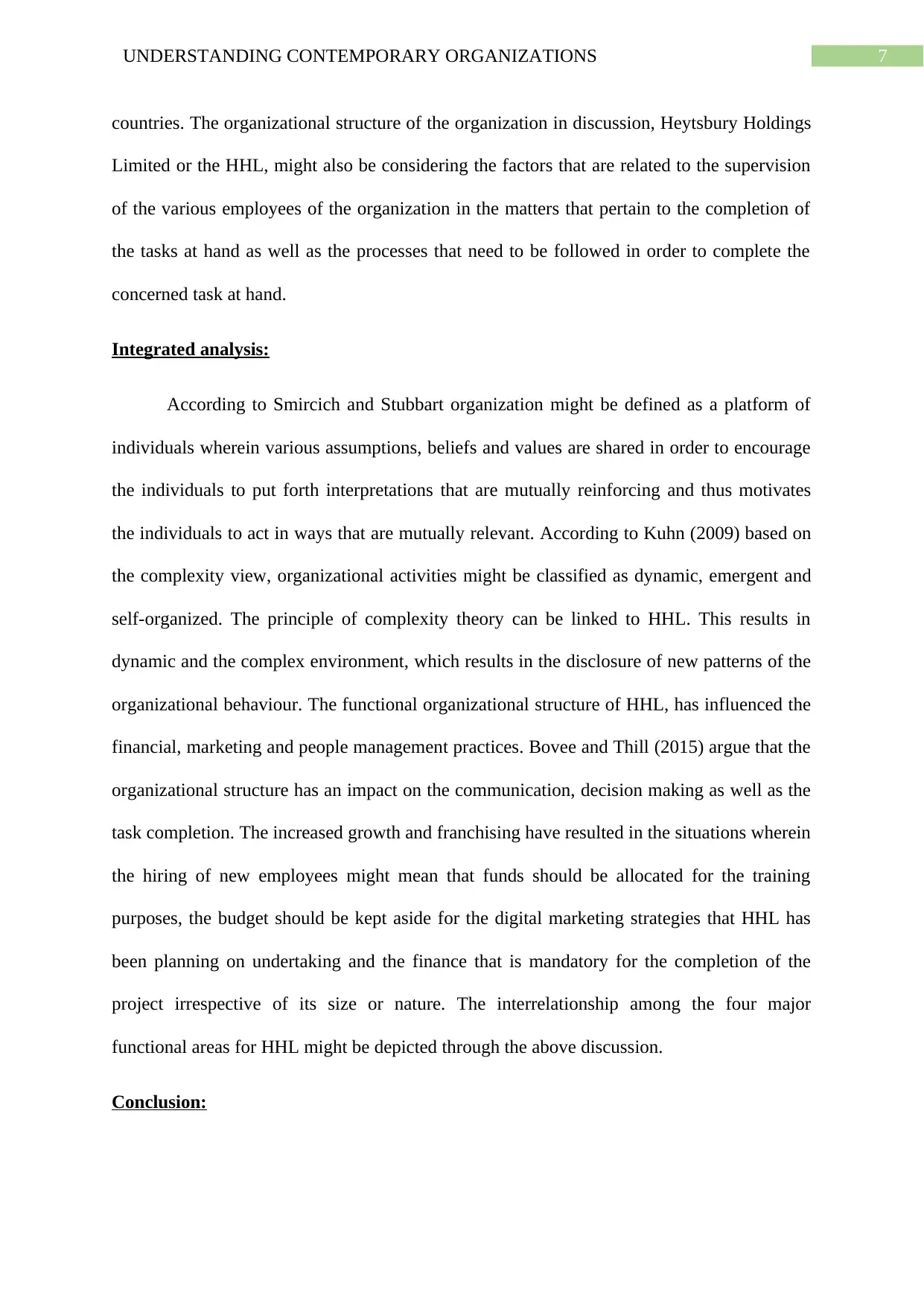
7UNDERSTANDING CONTEMPORARY ORGANIZATIONS
countries. The organizational structure of the organization in discussion, Heytsbury Holdings
Limited or the HHL, might also be considering the factors that are related to the supervision
of the various employees of the organization in the matters that pertain to the completion of
the tasks at hand as well as the processes that need to be followed in order to complete the
concerned task at hand.
Integrated analysis:
According to Smircich and Stubbart organization might be defined as a platform of
individuals wherein various assumptions, beliefs and values are shared in order to encourage
the individuals to put forth interpretations that are mutually reinforcing and thus motivates
the individuals to act in ways that are mutually relevant. According to Kuhn (2009) based on
the complexity view, organizational activities might be classified as dynamic, emergent and
self-organized. The principle of complexity theory can be linked to HHL. This results in
dynamic and the complex environment, which results in the disclosure of new patterns of the
organizational behaviour. The functional organizational structure of HHL, has influenced the
financial, marketing and people management practices. Bovee and Thill (2015) argue that the
organizational structure has an impact on the communication, decision making as well as the
task completion. The increased growth and franchising have resulted in the situations wherein
the hiring of new employees might mean that funds should be allocated for the training
purposes, the budget should be kept aside for the digital marketing strategies that HHL has
been planning on undertaking and the finance that is mandatory for the completion of the
project irrespective of its size or nature. The interrelationship among the four major
functional areas for HHL might be depicted through the above discussion.
Conclusion:
countries. The organizational structure of the organization in discussion, Heytsbury Holdings
Limited or the HHL, might also be considering the factors that are related to the supervision
of the various employees of the organization in the matters that pertain to the completion of
the tasks at hand as well as the processes that need to be followed in order to complete the
concerned task at hand.
Integrated analysis:
According to Smircich and Stubbart organization might be defined as a platform of
individuals wherein various assumptions, beliefs and values are shared in order to encourage
the individuals to put forth interpretations that are mutually reinforcing and thus motivates
the individuals to act in ways that are mutually relevant. According to Kuhn (2009) based on
the complexity view, organizational activities might be classified as dynamic, emergent and
self-organized. The principle of complexity theory can be linked to HHL. This results in
dynamic and the complex environment, which results in the disclosure of new patterns of the
organizational behaviour. The functional organizational structure of HHL, has influenced the
financial, marketing and people management practices. Bovee and Thill (2015) argue that the
organizational structure has an impact on the communication, decision making as well as the
task completion. The increased growth and franchising have resulted in the situations wherein
the hiring of new employees might mean that funds should be allocated for the training
purposes, the budget should be kept aside for the digital marketing strategies that HHL has
been planning on undertaking and the finance that is mandatory for the completion of the
project irrespective of its size or nature. The interrelationship among the four major
functional areas for HHL might be depicted through the above discussion.
Conclusion:
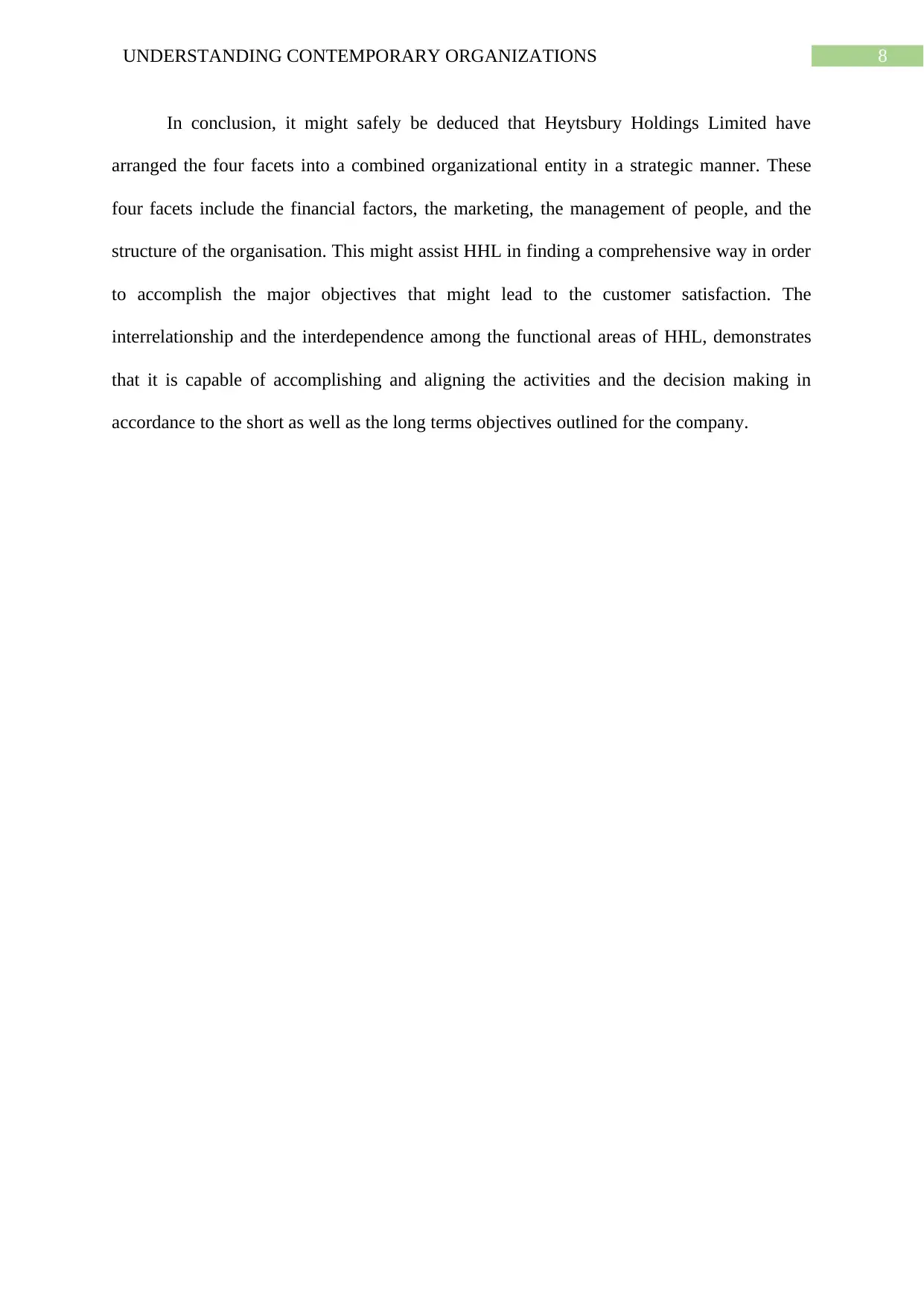
8UNDERSTANDING CONTEMPORARY ORGANIZATIONS
In conclusion, it might safely be deduced that Heytsbury Holdings Limited have
arranged the four facets into a combined organizational entity in a strategic manner. These
four facets include the financial factors, the marketing, the management of people, and the
structure of the organisation. This might assist HHL in finding a comprehensive way in order
to accomplish the major objectives that might lead to the customer satisfaction. The
interrelationship and the interdependence among the functional areas of HHL, demonstrates
that it is capable of accomplishing and aligning the activities and the decision making in
accordance to the short as well as the long terms objectives outlined for the company.
In conclusion, it might safely be deduced that Heytsbury Holdings Limited have
arranged the four facets into a combined organizational entity in a strategic manner. These
four facets include the financial factors, the marketing, the management of people, and the
structure of the organisation. This might assist HHL in finding a comprehensive way in order
to accomplish the major objectives that might lead to the customer satisfaction. The
interrelationship and the interdependence among the functional areas of HHL, demonstrates
that it is capable of accomplishing and aligning the activities and the decision making in
accordance to the short as well as the long terms objectives outlined for the company.
⊘ This is a preview!⊘
Do you want full access?
Subscribe today to unlock all pages.

Trusted by 1+ million students worldwide
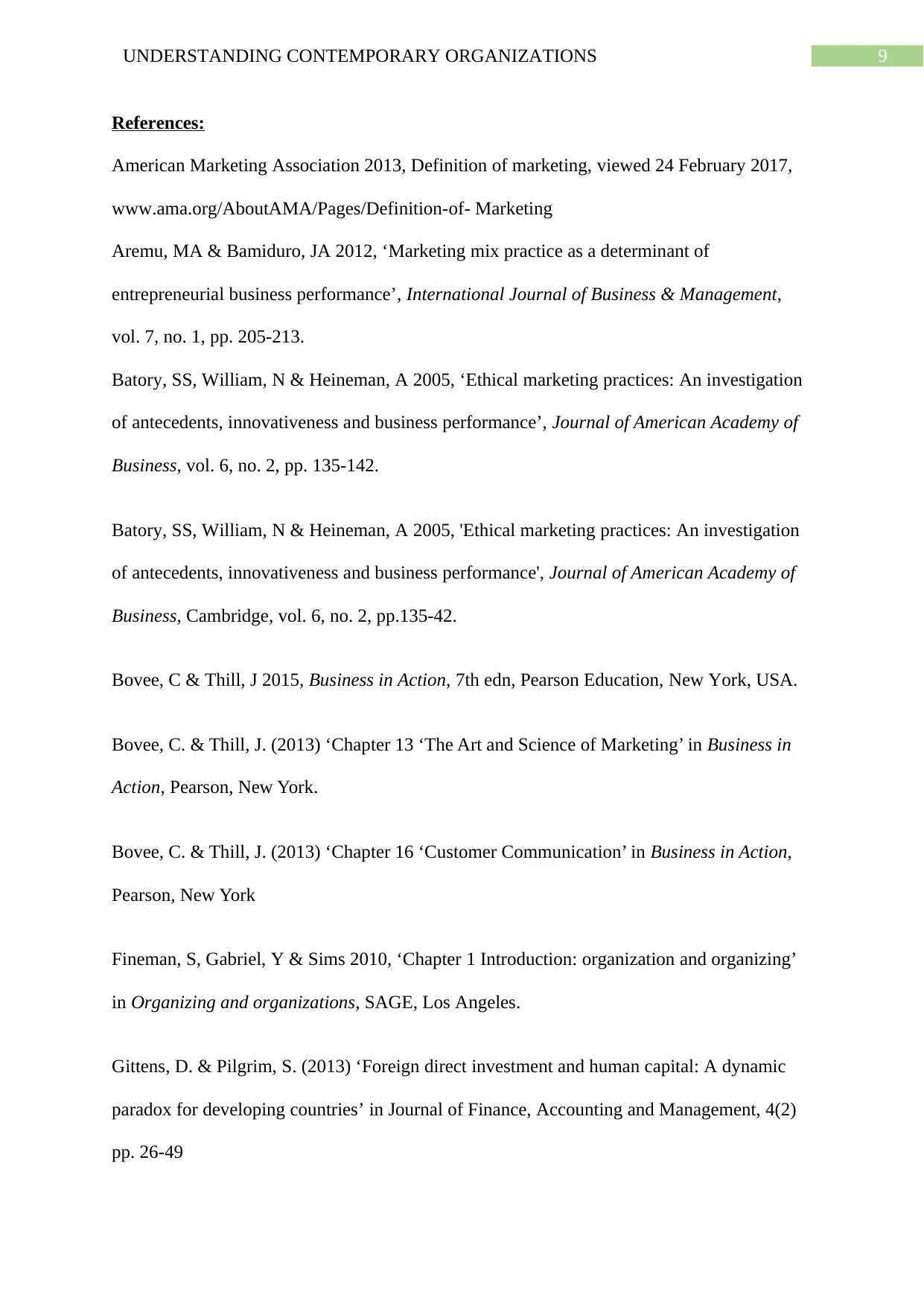
9UNDERSTANDING CONTEMPORARY ORGANIZATIONS
References:
American Marketing Association 2013, Definition of marketing, viewed 24 February 2017,
www.ama.org/AboutAMA/Pages/Definition-of- Marketing
Aremu, MA & Bamiduro, JA 2012, ‘Marketing mix practice as a determinant of
entrepreneurial business performance’, International Journal of Business & Management,
vol. 7, no. 1, pp. 205-213.
Batory, SS, William, N & Heineman, A 2005, ‘Ethical marketing practices: An investigation
of antecedents, innovativeness and business performance’, Journal of American Academy of
Business, vol. 6, no. 2, pp. 135-142.
Batory, SS, William, N & Heineman, A 2005, 'Ethical marketing practices: An investigation
of antecedents, innovativeness and business performance', Journal of American Academy of
Business, Cambridge, vol. 6, no. 2, pp.135-42.
Bovee, C & Thill, J 2015, Business in Action, 7th edn, Pearson Education, New York, USA.
Bovee, C. & Thill, J. (2013) ‘Chapter 13 ‘The Art and Science of Marketing’ in Business in
Action, Pearson, New York.
Bovee, C. & Thill, J. (2013) ‘Chapter 16 ‘Customer Communication’ in Business in Action,
Pearson, New York
Fineman, S, Gabriel, Y & Sims 2010, ‘Chapter 1 Introduction: organization and organizing’
in Organizing and organizations, SAGE, Los Angeles.
Gittens, D. & Pilgrim, S. (2013) ‘Foreign direct investment and human capital: A dynamic
paradox for developing countries’ in Journal of Finance, Accounting and Management, 4(2)
pp. 26-49
References:
American Marketing Association 2013, Definition of marketing, viewed 24 February 2017,
www.ama.org/AboutAMA/Pages/Definition-of- Marketing
Aremu, MA & Bamiduro, JA 2012, ‘Marketing mix practice as a determinant of
entrepreneurial business performance’, International Journal of Business & Management,
vol. 7, no. 1, pp. 205-213.
Batory, SS, William, N & Heineman, A 2005, ‘Ethical marketing practices: An investigation
of antecedents, innovativeness and business performance’, Journal of American Academy of
Business, vol. 6, no. 2, pp. 135-142.
Batory, SS, William, N & Heineman, A 2005, 'Ethical marketing practices: An investigation
of antecedents, innovativeness and business performance', Journal of American Academy of
Business, Cambridge, vol. 6, no. 2, pp.135-42.
Bovee, C & Thill, J 2015, Business in Action, 7th edn, Pearson Education, New York, USA.
Bovee, C. & Thill, J. (2013) ‘Chapter 13 ‘The Art and Science of Marketing’ in Business in
Action, Pearson, New York.
Bovee, C. & Thill, J. (2013) ‘Chapter 16 ‘Customer Communication’ in Business in Action,
Pearson, New York
Fineman, S, Gabriel, Y & Sims 2010, ‘Chapter 1 Introduction: organization and organizing’
in Organizing and organizations, SAGE, Los Angeles.
Gittens, D. & Pilgrim, S. (2013) ‘Foreign direct investment and human capital: A dynamic
paradox for developing countries’ in Journal of Finance, Accounting and Management, 4(2)
pp. 26-49
Paraphrase This Document
Need a fresh take? Get an instant paraphrase of this document with our AI Paraphraser
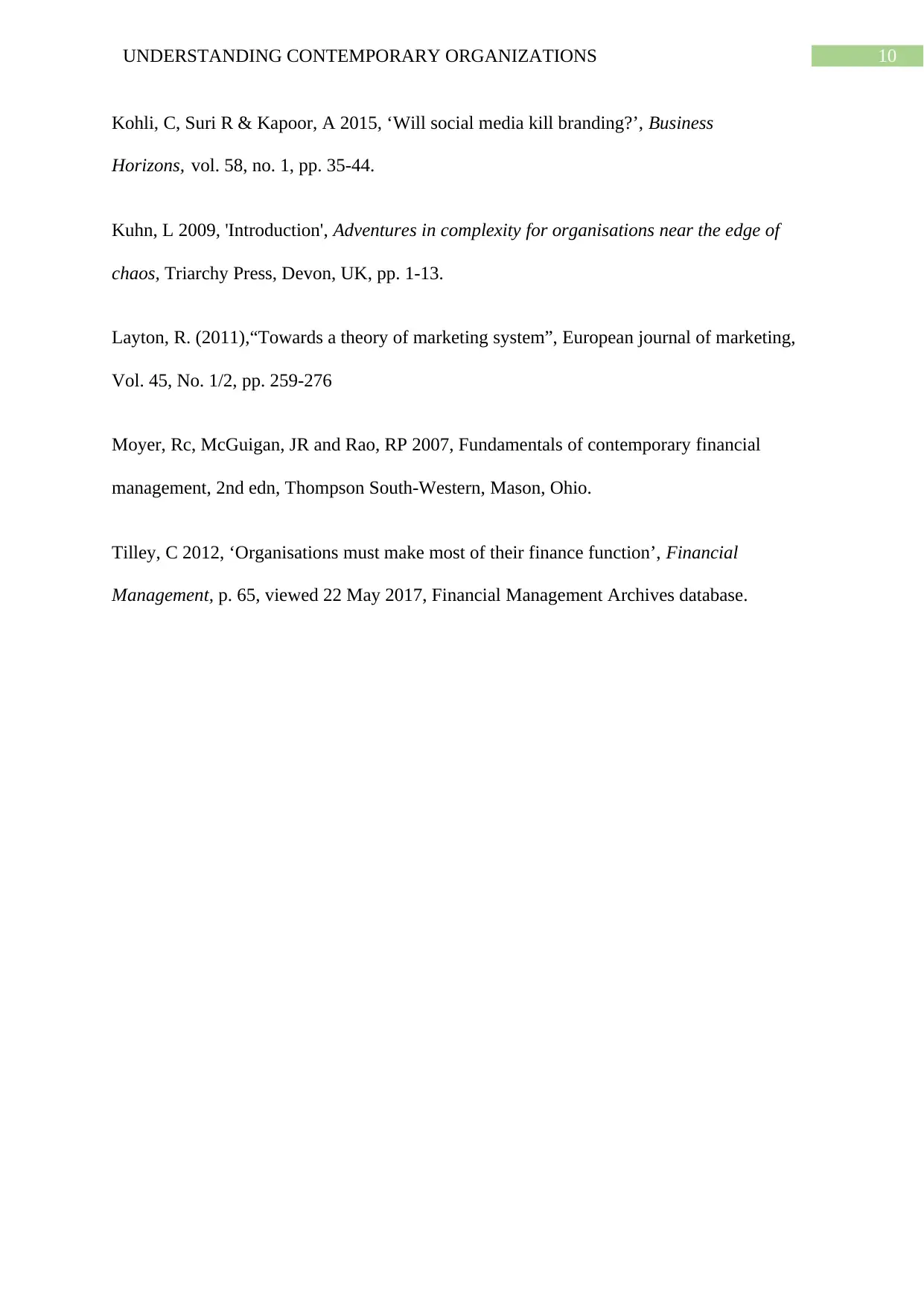
10UNDERSTANDING CONTEMPORARY ORGANIZATIONS
Kohli, C, Suri R & Kapoor, A 2015, ‘Will social media kill branding?’, Business
Horizons, vol. 58, no. 1, pp. 35-44.
Kuhn, L 2009, 'Introduction', Adventures in complexity for organisations near the edge of
chaos, Triarchy Press, Devon, UK, pp. 1-13.
Layton, R. (2011),“Towards a theory of marketing system”, European journal of marketing,
Vol. 45, No. 1/2, pp. 259-276
Moyer, Rc, McGuigan, JR and Rao, RP 2007, Fundamentals of contemporary financial
management, 2nd edn, Thompson South-Western, Mason, Ohio.
Tilley, C 2012, ‘Organisations must make most of their finance function’, Financial
Management, p. 65, viewed 22 May 2017, Financial Management Archives database.
Kohli, C, Suri R & Kapoor, A 2015, ‘Will social media kill branding?’, Business
Horizons, vol. 58, no. 1, pp. 35-44.
Kuhn, L 2009, 'Introduction', Adventures in complexity for organisations near the edge of
chaos, Triarchy Press, Devon, UK, pp. 1-13.
Layton, R. (2011),“Towards a theory of marketing system”, European journal of marketing,
Vol. 45, No. 1/2, pp. 259-276
Moyer, Rc, McGuigan, JR and Rao, RP 2007, Fundamentals of contemporary financial
management, 2nd edn, Thompson South-Western, Mason, Ohio.
Tilley, C 2012, ‘Organisations must make most of their finance function’, Financial
Management, p. 65, viewed 22 May 2017, Financial Management Archives database.
1 out of 11
Related Documents
Your All-in-One AI-Powered Toolkit for Academic Success.
+13062052269
info@desklib.com
Available 24*7 on WhatsApp / Email
![[object Object]](/_next/static/media/star-bottom.7253800d.svg)
Unlock your academic potential
Copyright © 2020–2025 A2Z Services. All Rights Reserved. Developed and managed by ZUCOL.



